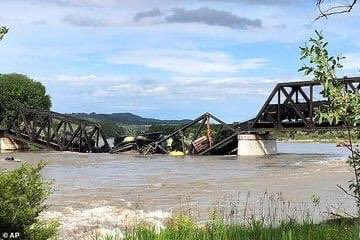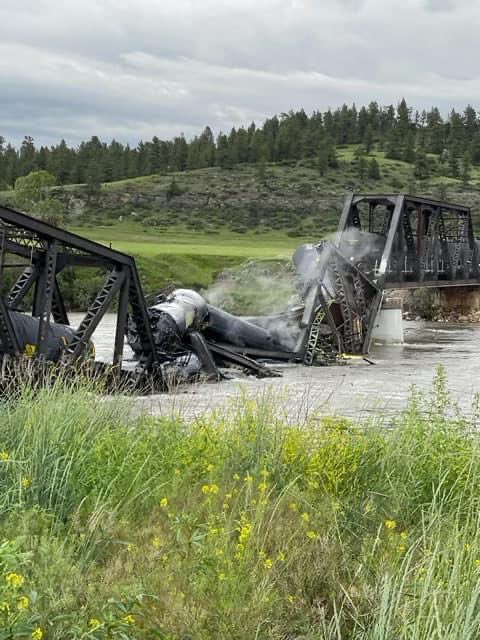Water intakes along the Yellowstone River have been shut off, following the collapse of a rail bridge, which sent several cars full of asphalt and sulfur into the water. Photos show crumpled, steaming tanker cars, and what appears to be bright yellow stuff roiling in the water. Pictures from Rawsalerts on Twitter:

The image is taken from the river banks downstream of the wreckage. Grass and shrubs in the foreground, then muddy, turbulent river water. The bridge and train run across the middle, and in the center, you can see yellow-white froth, where sulfur seems to be leaking into the water. In the background, forested hills under a partly cloudy sky.

The image is taken from the riverbank, near one end of the ruined rail bridge. You can see grass and yellow flowers in the foreground, with the river, bridge, and train in the middle. The tanker cars are twisted and crumpled, with steam hovering over them. If you look closely, you can see yellow in the water near the wreckage. In the background, a forested hill, under gray clouds.
This will keep happening, until the US government can stop kissing capitalist asses long enough to actually do its job, and overhaul the infrastructure of the whole damned country. The rails need to be nationalized, with profits from their use re-invested in maintaining, improving, and expanding the network. It seems that Montana’s had enough rain recently, that the stuff pouring into the river is pretty diluted, so cleanup workers are supposedly not at any risk. I have my doubts, obviously, but that’s what’s being reported:
COLUMBUS, Mont. — A bridge that crosses the Yellowstone River in Montana collapsed early Saturday, plunging portions of a freight train carrying hazardous materials into the rushing water below.
The train cars were carrying asphalt and sulfur, said David Stamey, Stillwater County’s chief of emergency services. Officials shut down drinking water intakes downstream while they evaluated the danger. An Associated Press reporter witnessed a yellow substance coming out of some of the tank cars.
However, Stamey said there was no immediate danger for the crews working at the site, and the hazardous material was being diluted by the swollen river. There were eight rail cars in the river or on the part of the bridge that collapsed.
The train crew was safe and no injuries were reported, Montana Rail Link spokesman Andy Garland said in a statement.
Railroad crews were at the scene in Stillwater County, near the town of Columbus, about 40 miles (about 64 kilometers) west of Billings. The area is in a sparsely populated section of the Yellowstone River Valley, surrounded by ranch and farmland. The river there flows away from Yellowstone National Park, which is about 110 miles (177 kilometers) southwest.
“We are committed to addressing any potential impacts to the area as a result of this incident and working to understand the reasons behind the accident,” Garland said.
In neighboring Yellowstone County, officials said they instituted emergency measures at water treatment plants due to the “potential hazmat spill” and asked residents to conserve water.
The cause of the collapse is under investigation. The river was swollen with recent heavy rains, but it’s unclear whether that was a factor.
Oh yeah, that’s the other thing – unless the US takes this seriously, climate change is going to keep putting more stress on its already-crumbling infrastructure. I don’t think climate change is the biggest factor here, given the overall neglect of the nation’s roads, rails, and bridges, but it’s more of a factor every year, and there’s no good excuse for not working to keep ahead of it.
I’m glad Yellowstone National Park won’t be directly affected, but while it’s a lovely place, all the other ecosystems along the river, including the river itself, also merit our concern. Obviously, there will be some human costs associated with this spill, but it’s hard for me to predict those at this stage. If you live downstream from this, along the Yellowstone river, or the Missouri river downstream of where the Yellowstone joins it, it’s probably a good idea to stock up on water, if you haven’t already.

Initial caveat: I do not know when this bridge was built.
That said.
This is one of the few industries in the US that actually suffered from over-regulation. During the late 1800s, railroads were the first really big business. And the railroads tried really hard to eliminate competition between cities. So, for instance, the Pennsylvania Railroad, the New York Central system, and the Erie Railroad all had New York City to Chicago lines. They were competitive in time and distance of the routes (well, the Erie was a little longer, but had fewer major hills to climb). And the PRR decided that they wanted a monopoly on the route. So they slashed the prices on through freight between NYC and Chicago. To make up for the losses, they pumped up the rates to and from any town or city that was served only by the PRR. Of course, the Erie and NYC both joined in and the three of them were all headed towards bankruptcy. And this happened on almost every line that had competition. Large railroads also tried to buy up as many small railroads as possible to create new through lines and create more captive customers.
Finally, in the late 1800s, the ICC stepped in to accomplish two things. First, provide rate protection for single road towns. Second, to stop the competing railroads bankrupting each other. It was not a perfect solution. There was politicking by representatives and senators. There was bribery. But it sort of worked while railroads had a virtual monopoly on both freight and passenger transportation.
After WWII, cars and, even more so, air travel made inroads into the passenger business. Trucking, especially unregulated trucking, made inroads into the more lucrative Less-than-CarLoad (LCL) business, as did the USPO’s parcel post system. And the ICC still saw its job as keeping rates as low as possible. In effect, the ICC had decided (without actually making the decision) to use railroads to subsidize almost all other industries in the US. Return on investment dropped from 5-7% for railroads in the 1920s and 1940s, down to -12% to 3%. And out of that ROI, the railroads had to pay dividends and invest in the physical plant — structures, yards, main lines. So by the 1960s, it cost the railroads more to borrow money than it could expect to make on the investment. Which means that investment in bridges ceased.
Railroading came close to collapsing in the 1970s and was saved by the US Congress and the Nixon administration. Then in the early 1980s, rate making was loosened up – it no longer took 1 to 5 years to put a new rate into effect, whether it was higher or lower. And railroads thrived.
But railroads still have low ROI if one includes the physical plant. And much of that physical plant still dates back to the mid-29th century. Including bridges. Norfolk Southern uses a bridge in Nicholson PA that dates back to the 1910s. Some of the bridges in the Harrisburg area date to the 1870s. Because, thanks to regulations under the ICC, the railroads did not have the capital to invest in new infrastructure.
So, depending on the age of the bridge, it could be under-regulation or over-regulation.
My own personal diagnosis is over-privatization, and under-valuing of public investment. I’m not interested in regulating the rail industry, so much as making the railways a national public service, and investing in it with the notion that it will pay off for everyone to do so.